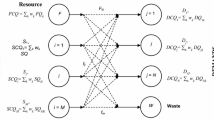Abstract
Allocation results for a multi-output process in a life cycle assessment study depend on the definition of the unit process which can vary with the depth of a study. The unit process may be a manufacturing site, a sub-process, or an operational unit (e.g. distillation column or reactor). There are three different approaches to define a unit process: macroscopic approach, quasi-microscopic approach, and microscopic approach. In the macroscopic approach, a unit process is the manufacturing site, while a unit process in the quasi-microscopic approach is a sub-process of the manufacturing site. An operational unit becomes the unit process in the microscopic approach.
In the quasi-microscopic and the microscopic approaches, a process can be subdivided into a joint process, a physically separated process which is physically apart from other processes, and a fully separated process. Each type can be a unit process. Therefore, the multi-output process in the quasi-microscopic and the microscopic approaches can be subdivided among two or more unit processes depending on the actual operations.
The allocation in the fully separated process can be avoided because this process fulfills one function. In the joint process and the physically separated process, which deliver two or more functions, allocation is still required.
Ammonia manufacturing, where carbon dioxide is formed as a byproduct is given to show a specific detailed example of the allocation procedure by subdivision in ISO 14041. It is shown that the quasi-microscopic and the microscopic approaches can reduce the multi-output allocation of a given chemical product. Furthermore, the quasi-microscopic and the microscopic approaches are very useful in identifying key pollution prevention issues related with one product or function.
Similar content being viewed by others
References
Azapagic, A.;Clift, R. (1998): Linear Programming as a Tool in Life Cycle Assessment. International Journal of Life Cycle Assessment, 3 (6), 305–316
Frischknecht, R. (1998): Life Cycle Inventory Analysis for Decision-Making. Ph.D. thesis, Swiss Federal Institute of Technology, Switzerland
Ekvall, T. (1999): System Expansion and Allocation in Life Cycle Assessment with Implications for Wastepaper Management. Ph.D. thesis, Chalmers University of Technology, Sweden
Huppes, G. (1994): A General Method for Allocation in LCA. Proceedings of Allocation in LCA. SETAC-Europe, p.74
ISO 14041 (1998): Environmental Management — Life Cycle Assessment — Goal and Scope Definition and Inventory Analysis
ISO 14040 (1997): Environmental Management — Life Cycle Assessment — Principles and Framework
Gerhartz, W.;Yamamoto, Y.S;Campbell, F.T;Pfefferkorn, R;Rounsaville, J.F. (Eds) (1985): Ullmann’s Encyclopedia of Industrial Chemistry. 5th edition, VCH Verlagsgesellschaft, Weinheim, Federal Republic of Germany
Slack, V.;James R.G. (Eds) (1973): Ammonia. Marcel Dekker, Inc., New York, USA
Brykowski, F.J. (Ed) (1981): Ammonia and Synthesis Gas: Recent and Energy-Saving Processes. Noyes Data Corporation, Park Ridge, NJ, USA
Kroschwrrz, J.I. (Ed) (1992): Kirk-Othmer Encyclopedia of Chemical Technology. 4th edition, John Wiley & Sons, New York, USA
EFMA (1995): Production of Ammonia, European Fertilizer Manufacturer’s Association. Brussels, Belgium
Jiménez-González, C.;Kim, S.;Overcash, M. (1999): Methodology for Developing Gate-to-Gate Life Cycle Inventory Information, submitted to International Journal of Life Cycle Assessment
Kim, S;Hwang, T.;Lee, K.M. (1997): Allocation for LCA cascade recycling system. International Journal of Life Cycle Assessment, 2 (4), 217–222
Author information
Authors and Affiliations
Corresponding author
Rights and permissions
About this article
Cite this article
Kim, S., Overcash, M. Allocation procedure in multi-output process: an illustration of ISO 14041. Int. J. LCA 5, 221–228 (2000). https://doi.org/10.1007/BF02979363
Received:
Accepted:
Issue Date:
DOI: https://doi.org/10.1007/BF02979363




